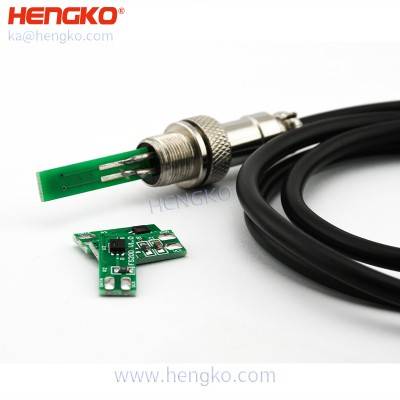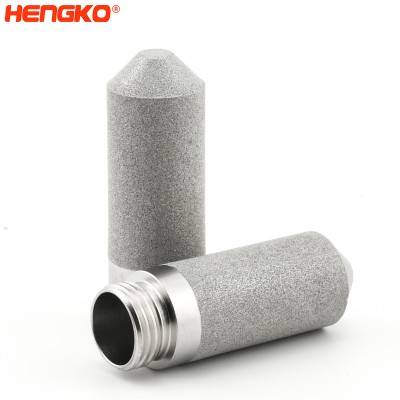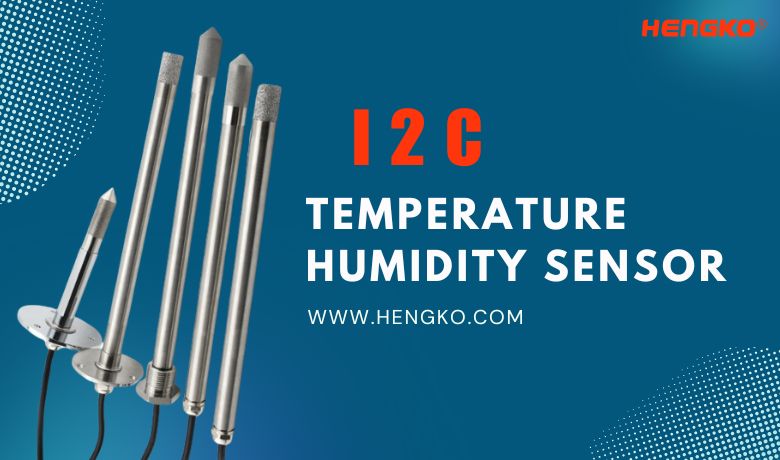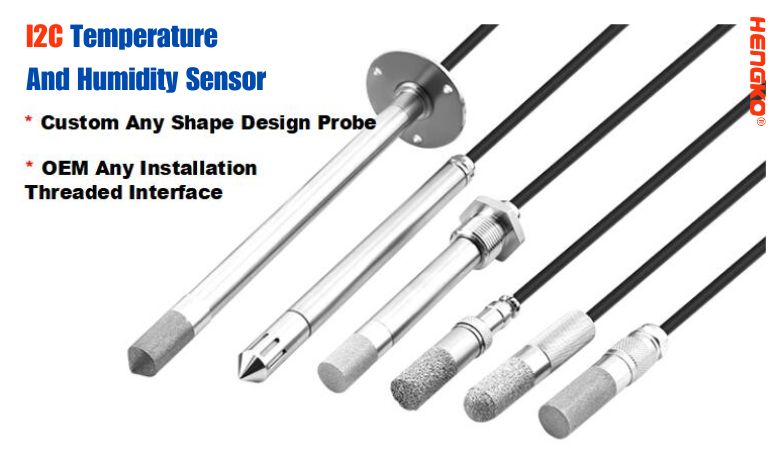-

PCB circuit board assembly for I2c humidity temperature sensor waterproof for environme...
HENGKO temperature and humidity module adopt high precision RHT series sensor equipped with a sintered metal filter shell for large air permeability, fast ga...
View Detail -

Sensirion Wifi digital Sensor i2c humidity module Porous Metal Weather-proof Temperatur...
HENGKO wifi digital temperature and humidity module adopts high precision RHT series sensor equipped with a sintered metal filter shell for large air permeab...
View Detail
Main Features of i2c Temperature Humidity Sensor
The main features of our i2c Temperature Humidity Sensor include:
* Accurate Measurement: Provides precise and reliable readings of temperature and humidity levels.
* Wide Application Range: Suitable for various industries and environments, including agriculture, HVAC, storage facilities, and more.
* Easy Integration: Supports i2c communication protocol, allowing seamless integration into existing systems or microcontroller platforms.
* Low Power Consumption: Designed to operate efficiently, consuming minimal power while delivering accurate measurements.
* Compact and Durable: Compact size for easy installation and placement, with a robust design to withstand harsh conditions.
* Customizable Options: Flexibility in design and customization, enabling you to select sensor specifications that meet your specific requirements.
Output Types of Temperature Humidity Sensor
Temperature Humidity Sensors can have various output types, including:
1. Analog Output: Provides continuous voltage or current signals proportional to the measured temperature and humidity values.
2. Digital Output: Offers digital signals, such as I2C (Inter-Integrated Circuit) or SPI (Serial Peripheral Interface), transmitting temperature and humidity data in a digital format.
3. UART Output: Uses Universal Asynchronous Receiver-Transmitter (UART) communication protocol to transmit temperature and humidity readings as serial data.
4. Wireless Output: Utilizes wireless communication protocols like Bluetooth or Wi-Fi to transmit temperature and humidity data to a receiver or a connected device.
5. USB Output: Provides temperature and humidity data through a USB connection, allowing direct communication with a computer or other USB-enabled devices.
6. Display Output: Features a built-in display that shows temperature and humidity readings directly on the sensor itself.
The choice of output type depends on the specific application requirements and the compatibility with the receiving device or system.
Which one is More Popular output People to use, I2C, 4-20mA, RS485 ?
Among the mentioned options Above, the popularity of the output types varies depending on the specific application and industry. However, in many cases, the I2C (Inter-Integrated Circuit) output is widely used and popular due to its ease of integration and compatibility with microcontroller platforms. It allows for simple communication between the sensor and other devices, making it suitable for various applications.
The 4-20mA output is commonly used in industrial applications where long-distance transmission and noise immunity are crucial. It provides a standardized current signal that can be easily converted and transmitted over long distances.
RS485, on the other hand, is a robust communication protocol commonly used in industrial automation and control systems. It enables reliable data transmission over long distances, making it suitable for applications that require long-range communication and multi-device networking.
Ultimately, the popularity of the output type depends on the specific requirements and the industry in which the temperature humidity sensor is being used.
Some Specific Applications of i2c Temperature Humidity Sensor
Here we list some popular applications of Temperature Humidity Sensor, Specially more like to
use I2C output Temperature and Humidity Sensor, hope it will be helpful for your understanding
Our Products and Applications.
1. HVAC Systems:
The i2c Temperature Humidity Sensor finds extensive application in Heating, Ventilation, and Air Conditioning (HVAC) systems. It provides real-time monitoring of temperature and humidity levels, enabling efficient climate control. By accurately measuring these parameters, the sensor helps optimize energy consumption and ensures occupant comfort. The i2c output allows seamless integration with HVAC controllers, enabling precise temperature and humidity regulation for enhanced system performance and energy efficiency.
2. Agriculture and Greenhouses:
In agricultural settings, maintaining optimal temperature and humidity levels is crucial for plant growth and yield. The i2c Temperature Humidity Sensor is employed to monitor and control environmental conditions within greenhouses, grow rooms, or crop storage facilities. By continuously measuring temperature and humidity, farmers can implement appropriate ventilation, irrigation, and heating systems. This ensures ideal conditions for crop growth, prevents disease, and maximizes productivity.
3. Data Centers:
Data centers require strict climate control to safeguard sensitive equipment and maintain operational efficiency. The i2c Temperature Humidity Sensor plays a vital role in monitoring and managing temperature and humidity within data center facilities. By accurately measuring these parameters, it helps prevent overheating, condensation, and equipment failures. With the i2c output, data center operators can integrate the sensor data into their monitoring systems, enabling proactive maintenance and preventing costly downtime.
4. Food Storage and Warehousing:
The i2c Temperature Humidity Sensor is utilized in food storage facilities and warehouses to ensure optimal conditions for food preservation and quality control. By monitoring temperature and humidity, it helps maintain the freshness, flavor, and safety of stored food products. The sensor's i2c output enables seamless integration with data loggers or inventory management systems, facilitating real-time monitoring and automated alerts for any deviations from the desired environmental conditions.
5. Pharmaceuticals and Laboratories:
In pharmaceutical manufacturing and laboratory settings, strict control of temperature and humidity is crucial to ensure product stability and accuracy of experiments. The i2c Temperature Humidity Sensor provides precise monitoring of these parameters, helping maintain the required conditions for drug manufacturing, research, and testing. Its i2c output enables seamless integration with laboratory information management systems (LIMS) or process control systems, ensuring compliance with regulatory standards and maintaining product integrity.
Overall, the i2c Temperature Humidity Sensor offers reliable and accurate measurement capabilities for a wide range of applications. Its integration-friendly i2c output allows for seamless connectivity with various systems and enables real-time monitoring, control, and automation, leading to enhanced efficiency, productivity, and quality in diverse industries.
How is an i2c Temperature Humidity Sensor work ?
An i2c Temperature Humidity Sensor operates by utilizing the i2c (Inter-Integrated Circuit) communication protocol. The sensor contains integrated temperature and humidity sensing elements, often in the form of specialized ICs (Integrated Circuits). These sensing elements detect changes in temperature and humidity and convert them into electrical signals.
The i2c protocol allows the sensor to communicate with a microcontroller or other devices using two wires: a data line (SDA) and a clock line (SCL). The sensor acts as a slave device on the i2c bus, while the microcontroller serves as the master.
The communication process begins with the microcontroller initiating a start signal and addressing the i2c Temperature Humidity Sensor. The sensor responds by acknowledging the address. The microcontroller then sends a command to request temperature or humidity data.
Upon receiving the command, the sensor retrieves the corresponding data from its sensing elements and converts it into a digital format. It then transmits the data to the microcontroller through the i2c bus. The microcontroller receives the data and can further process it or utilize it for various purposes, such as control actions, display, logging, or transmission to other systems.
The i2c protocol enables bi-directional communication, allowing the microcontroller to both request data from the sensor and send configuration or control commands to it.
By utilizing this communication protocol, the i2c Temperature Humidity Sensor provides an efficient and standardized way to interface with microcontrollers, facilitating accurate and reliable measurement and control of temperature and humidity levels in diverse applications.
FAQ
1. What is the function of an i2c Temperature Humidity Sensor?
The function of an i2c Temperature Humidity Sensor is to accurately measure and monitor temperature and humidity levels in various applications. It collects data on these parameters and provides real-time information, allowing users to make informed decisions regarding climate control, energy optimization, process regulation, and quality assurance. By capturing and relaying precise temperature and humidity readings, the sensor enables precise monitoring and control in industries such as HVAC, agriculture, data centers, and more.
2. In which applications can i2c Temperature Humidity Sensors be used?
i2c Temperature Humidity Sensors have a wide range of applications, including HVAC systems, agriculture and greenhouses, data centers, food storage and warehousing, pharmaceuticals and laboratories, weather monitoring, home automation, and more. They are used wherever precise temperature and humidity measurements are critical for maintaining optimal conditions, safety, and efficiency.
3. How is an i2c Temperature Humidity Sensor installed ?
The installation process for an i2c Temperature Humidity Sensor may vary depending on the specific model and application. Generally, it involves connecting the sensor to the i2c bus of a microcontroller or system, ensuring proper power supply, and establishing the necessary communication protocol. Some sensors may require additional wiring or mounting considerations. It is recommended to follow the manufacturer's installation guidelines provided with the sensor.
4. How accurate are i2c Temperature Humidity Sensors ?
The accuracy of i2c Temperature Humidity Sensors can vary depending on the sensor model and specifications. Generally, high-quality sensors offer a high degree of accuracy, often within a few percentage points for humidity and a fraction of a degree Celsius for temperature measurements. It is important to review the datasheet or product specifications to determine the accuracy of a specific sensor model.
5. Can i2c Temperature Humidity Sensors be calibrated?
Yes, many i2c Temperature Humidity Sensors can be calibrated or adjusted to enhance their accuracy. Calibration processes may involve exposing the sensor to known reference conditions and adjusting its readings accordingly. However, it is recommended to consult the manufacturer's guidelines or seek professional calibration services to ensure accurate and reliable measurements.
6. Can multiple i2c Temperature Humidity Sensors be connected to a single bus?
Yes, multiple i2c Temperature Humidity Sensors can be connected to a single i2c bus using unique addresses assigned to each sensor. This allows for simultaneous monitoring of multiple locations or parameters within a system. However, it is important to ensure that the microcontroller or system can support the desired number of sensors and manage the data communication effectively.
7. How often should i2c Temperature Humidity Sensors be recalibrated?
The frequency of recalibration depends on several factors, including the sensor's accuracy requirements, environmental conditions, and the specific application. As a general guideline, it is recommended to recalibrate i2c Temperature Humidity Sensors annually or as specified by the manufacturer. However, critical applications or those subject to harsh environments may require more frequent recalibration to maintain optimal performance.
We would be delighted to assist you further! For any inquiries or more information about our i2c Temperature Humidity Sensors,
please feel free to contact us via email at ka@hengko.com. Our dedicated team is ready to provide prompt and professional
support tailored to your needs. We look forward to hearing from you soon.








